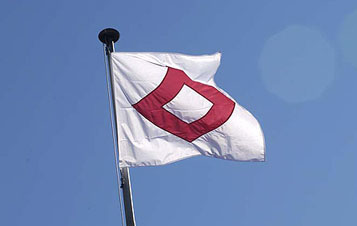gov
The published study, “Text and Graphic Warnings on Cigarette Packages Findings from the International Tobacco Control Four Country Study,” is available as a 2.4MB PDF from researcher David Hammond’s site.

Red Crystal

The Geneva Conventions were amended today to address a question of branding.
The Third Additional Protocol to the 1949 Geneva Conventions entered into force today, completing the process of establishing an additional emblem for use by Governments and the International Red Cross and Red Crescent Movement. So far, 84 States have signed the Third Protocol and nine States have ratified it.
The red crystal symbol is now officially recognized under international law as offering equal protection as the red cross and the red crescent when marking: “military medical personnel, establishments and transport; the staff of national societies; staff, vehicles and structures of the ICRC and the International Federation.”
From the ICRC Factsheet:
“The new symbol is intended to facilitate access by humanitarian workers to victims of conflict and other crises, in particular in situations where the use of an emblem devoid of any perceived political, religious, cultural and connotations may be an advantage.”
See the full text of the Additional Protocol. (Thanks, Romualdo!)




The Wikipedia article on the Red Crystal summarizes the debates over religion, politics, and the origins of the various symbols used by humanitarian aid organizations.
...
Also from Wikipedia, the Red Swastika is a symbol used by a voluntary charitable association founded in China in 1922:
“Suppressed by during the Communist rule in mainland China, the Red Swastika Society appears to continue today as a religious organization focused on charity. It has branches in areas of the Chinese diaspora, with a headquarters in Taiwan. Besides charity work, the Red Swastika runs two schools in Hong Kong (Tuen Mun and Tai Po) and one in Singapore (Red Swastika School).
The Red Swastika was also suggested along with Red Wheel, as an emblem of International Federation of Red Cross and Red Crescent societies for India and Sri Lanka, but the idea was not put into practice.”
 This year’s National Design Award winners in graphic design refuse to attend the awards breakfast with Laura Bush at the White House. See their joint letter in protest at Design Observer, as well as Chip Kidd’s reasons why he chose to go anyway. Regarding the Administration, I can think of a few more specific crimes than “crimes against discourse” and an “assault on meaning,” but it’s nice to see some graphic design heavyweights taking political action.
This year’s National Design Award winners in graphic design refuse to attend the awards breakfast with Laura Bush at the White House. See their joint letter in protest at Design Observer, as well as Chip Kidd’s reasons why he chose to go anyway. Regarding the Administration, I can think of a few more specific crimes than “crimes against discourse” and an “assault on meaning,” but it’s nice to see some graphic design heavyweights taking political action.Domestic Policy
Another item I missed while out, on May 24, President Bush appointed Karl Zinsmeister as his chief domestic policy advisor (replacing Claude Allen who resigned in February when caught stealing from Target.) Judging from the appointment, the domestic agenda seems more about propaganda than poverty.
His qualifications? Zinsmeister was editor of The American Enterprise, the magazine of the American Enterprise Institute, a neo-conservative think tank whose stated mission is to support the “foundations of freedom — limited government, private enterprise, vital cultural and political institutions, and a strong foreign policy and national defense.” Among the organization’s funders are both Microsoft and the Scaife family.
Also on his resume, in 2003, Zinsmeister was embedded as a military reporter with the 82nd Airborne in Iraq. His Iraq experience is chronicled in Combat Zone: True Tales of GI’s in Iraq, which Zinsmeister wrote for Marvel Comics. [source] The comic excludes accounts of torture and detainee abuse by the 82nd Airborne later documented by Human Rights Watch.
Further qualifying him, is Zinsmeister’s 2002 essay When Art Becomes Inhuman, a critique of modern art, liberals, and, of course, Manhattan. [source]. His rant against abstraction is an ironic reversal from the days when the CIA helped promote abstract expressionism at the expense of social realism to keep the Commies at bay. Nowadays, with abstraction duly en-framed in the canon of modern art, it makes easy fodder for the ‘liberals are elitist snobs’ line of right-wing populists.
Among his accusations, is one about lefty directors of musical theater who “believe audiences should absorb ideological messages in the theater, not beautiful songs.” This is of course coming from his own ideological screed. But it’s also a further note of just how ideological the apparent ‘invisibility’ and ‘neutrality’ of beauty really is.
This Land is My Land
From a June 1 editorial in the Wall Street Journal Asia on events leading up to the recent violence in East Timor:
“[Former Prime Minister of East Timor, Mari] Alkatiri entered into a kind of siege mindset, centralizing power and implementing a series of decisions that alienated wide swathes of his political base. Most unpopular was the decision to make Portuguese — a language of the exiles, but not of the nation — the official language. Fretilin also adopted the national flag as its party symbol, a not-so-subtle claim to absolute power.”
All City, 2
Back in town and still catching up, but here’s an quick update on a recent blog item:
On Monday, June 5, 2006, the US Conference of Mayors adopted the ‘2030 Challenge,’ a resolution committing to a timeline for reducing greenhouse gas emissions by all new and renovated city buildings to the point that all new city buildings are carbon-neutral by 2030.
On May 31, 2006, the City of Santa Fe became the first city in the US to formally adopt the ‘2030 Challenge’.
The 78,000 member American Institute of Architects formally adopted the ‘2030 Challenge’ in January 2006.


